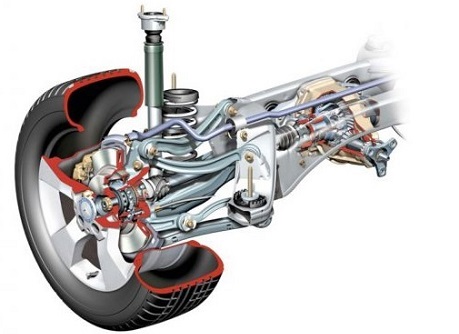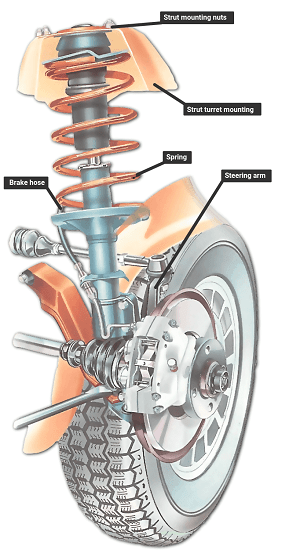
Car Suspension Repair – Problems, Solutions, Costs and FAQs
A massive pothole in the road ahead can’t always be skipped, and it can be hazardous to try to swerve around it. Therefore, you’re going to be feeling a big bump, and so is your vehicle. During the time, those bumps can add up to issues with your suspension. A large bump can even cause your car to “bottom out,” meaning the bottom of your vehicle could hit the road. In that case, you’ll need a car suspension repair immediately.
Inspect and maintain your suspension system’s different parts with this troubleshooting guide designed especially for car owners.
How Does It Work?
Suspension is responsible for smoothing out the drive and keeping the vehicle in control. Specifically, it maximizes the friction between the tires and the road to deliver steering stability and proper handling. This system also delivers comfort for passengers to limiting the impact of particular road conditions to not only the car but the passengers too.
Main components
There are three chief components of a suspension system.
- Springs, which are typically found in coil form. Some older car leaf spring systems and some custom vehicles may have been outfitted with air-ride systems. Anyway, the springs are configured, they’re there to absorb bumps and maintain a consistent car drive height.
- Next to the springs, you have shock absorbers (shocks) and
- Struts, which are two different parts. You may hear people talked about them interchangeably, but most cars have either struts or shocks. Occasionally, you’ll find a vehicle with rear shocks and front struts. It’s recommended to familiarize yourself with your own car’s suspension system, so you can better understand what maintenance will be needed.

What Are the Typical Car Suspension Problems?
These are the most common signs of bad suspension in your car, especially after an accident.
- Bumpy ride – Most folks can tell their shock or struts are wearing out when they begin to feel every crack in the road, or even every crack causes the vehicle body to bounce. A rough drive is an obvious sign that your car suspension needs work;
- Steering problem – With a poor system, you’ll often feel the car “drift” or pull when you’re turning. It means the shocks are no longer keeping the car body stable versus the centrifugal force of a turn, increasing the risk of a rollover. If you experience this while turning, it’s time to take the vehicle to your auto repair shop for servicing;
- Dips when stopping – Once the shocks are worn out, you’re likely to feel the vehicle body swaying forward and downward nose-first when you push the brakes firmly. It can affect your ability to stop the car quickly (it can increase stop time by up to 20%);
- Uneven tire treads – If you see the tread is wearing down unevenly on the tires, or if you notice balding spots, this’s often a symptom that the mechanism isn’t holding the car evenly, and as a result – putting uneven amounts of pressure on the tires;
- Oily or greasy shocks – If you can look under the vehicle, take a look directly at the struts or shocks. If they look oily or greasy, there’s a high possibility that they’re leaking fluid and therefore aren’t working correctly. It’s the time to get them replaced;
- Bounce test – If you suspect this system is going bad (thanks to one or more symptoms we mentioned above), try this test. With the vehicle in “park,” press down on the front of the car with all your weight and “bounce” it a few times. Repeat it on the rear of the car. If the vehicle continues to bounce or rock more than 2-3 times after you release it, this mechanism is wearing out;
- One side sits low – If you notice that one side of your car seems to be a lot lower than the other, there’s a high possibility you have a worn or damaged spring. You may also see a clunking noise as you drive over a deep pothole or bumps.

Suspension Repair Costs
Below are the factors that affect automobile suspension repair cost.
The make and model of your vehicle
The cost depends on the make, model, and year of the car. On performance or luxury vehicles such as a big sedan or an SUV, the cost will tend to be higher. Still, if it’s an old car with rust underneath, it can be time-consuming for a mechanic to access/remove old parts, which may result in a higher price, too.
The parts and the damages that need replacing
It’s difficult to estimate an average suspension repair cost. The price covers the part itself, labor costs, and also the complexity of the replacement. In this process, parts tend to be replaced in couples. It means that the right and left struts would be replaced, for instance. It’s also typical to have both the front and rear parts updated simultaneously – in order to maintain balance and stability as well as prevent old partly-worn parts from stressing new components.
If you repaired only one side, it would make imbalance – more stress will be applied on the side that hasn’t been done, and decrease its life expectancy. Your vehicle may also require a wheel alignment after replacing components, further elevating the cost of the fix.
The local suspension shops
Repair costs vary dramatically by area and depend on your mechanic too, so it’s essential to visit a local auto suspension shop to get a repair estimate. The setup of a new system is complicated. The replacement may be combined with diagnostics and tests to ensure optimal balance.
Brand
Ask your local mechanics which brand they recommend. Prices vary for different parts manufacturers. They depend on the quality of materials, design, and any product upgrades that make them more efficient or durable. It may be alluring to choose the cheapest replacement parts. But, if you opt for a trustworthy brand, you’re more likely to save money in the long-term through good-value robust components.
Car insurance
Check with the insurer whether you’re covered for the suspension repair. It’ll depend on why it’s needed – was it from a collision or impact, or typical wear and tear? If you own standard insurance, general wear won’t be covered, but the insurer may cover the cost if you’re not guilty for a particular incident. Insurance policies vary greatly, with some covering both labor and parts costs, while others are only guaranteeing the cost of the replacement parts.
The 4 Most Expensive Car Suspension Repairs
Here are the top four most expensive vehicle suspension repairs.
1. Shocks and struts
Strut and shocks repairs can stop your vehicle from pulling in a certain direction while you drive and minimize friction. Checking this system for wear-and-tear after every 50,000 to 60,000 miles is mandatory. A set of 4 shocks averages around $1,400, but the price may jump depending on the type of vehicle you drive.
2. Spring replacement
Spring repairs will reduce bounce, improve stability, and make it easier to operate. Depending on your car, the average cost of a coil spring replacement is around $380. The total cost may change based on your model, the extent of repair, and how many springs needed to fix or replace.
3. Ball joint replacement
Ball joints connect your vehicle’s wheel and tire to the suspension mechanism. Replacing one costs about $150, but a set of four could run closer to $900. Some cars only have front ball joints while others have them in the back too.
4. Total system
When it comes to total system service, you may need front repairs, rear fixes, or an all-around overhaul. In extreme situations, a mechanic may suggest replacing the entire system due to structural damages. In this case, expect to spend at least $3,000, excluding auto repair shop costs for labor.


FAQs
How to Tell if Shocks Are Bad?
Signs of car shocks and struts in lousy conditions are unusual noises over bumps, the excessive body leans or sways in turns, or that the front end of the car dives sharply in hard braking. Bad shocks also can affect steering control and cause uneven tire wear.
How Long Do Struts and Shocks Last on a Vehicle?
Shocks, struts, and springs are typically designed to last long. Under normal driving conditions with minimal potholes, bumps, and other road surface issues, shocks and struts can last up to 10 years. Still, if you’re taking your vehicle on daily grind literally, you’ll see that this 10-year span is usually shorter. Standardly, most automotive manufacturers recommend changing the shock absorber every 40k or 50k miles.
Why are My Shocks Squeaking?
The squeaking noise that comes from this mechanism can be due to issues in the bushings. It’s possible that there is tear in the rubber or even the bushing has already worn out completely. Sometimes, it’s also possible that the squeaking sound actually originated from inside the metal sleeve located within the vibration isolator.
It’s also possible that the squeaking sound arrives from a ruined rubber boot covering a ball joint or a worn/torn rubber mount. Whatever the case, it’s imperative that you have a suspension check automatically to determine the real reason for the squeaking and for the proper management to be carried out as soon as possible.
